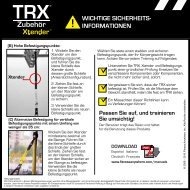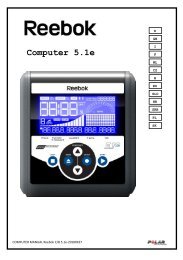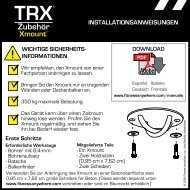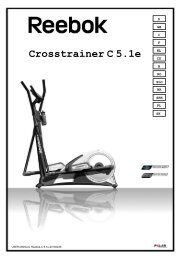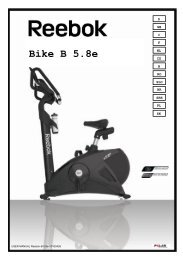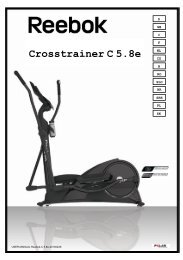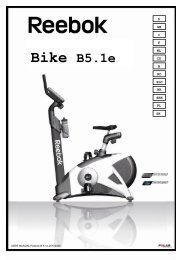by Body-Solid® - Fitness4all
by Body-Solid® - Fitness4all
by Body-Solid® - Fitness4all
You also want an ePaper? Increase the reach of your titles
YUMPU automatically turns print PDFs into web optimized ePapers that Google loves.
TRAINING TIPS<br />
FOR BEGINNER’S<br />
A R E Y O U A “ B E G I N N E R ” ?<br />
A beginner can be classified as someone who has never touched a weight, may have lifted for a while,<br />
but has taken a substantial amount of time off, or has not consistently trained over the last six months.<br />
If you happen to fall into any of these categories, pay close attention, because the following information<br />
will be detrimental to the start of your training program.<br />
As a beginner, one of the most common mistakes is doing<br />
too much. Because beginners often make good gains<br />
quickly, many fall into the trap of thinking that more is better.<br />
This may be true later in the training equation, but not for the<br />
novice. Some of the most common injuries occur as a result<br />
of taking on too much, too soon.<br />
One of the questions most frequently asked is, “How much<br />
weight should I use?” Determining the weight for each<br />
exercise will vary from person to person. The weight for each<br />
exercise will be lifted in sets and repetitions. Repetition<br />
is defined as one execution of any exercise. A set is a<br />
combination of any number of repetitions of one exercise.<br />
Experimentation at each exercise station is a good technique<br />
for determining the starting weight for an individual. Take the<br />
chest press exercise for example. Performing this exercise<br />
with a weight that can be pressed 30 times with ease will<br />
not help you achieve any particular goals. Adding the<br />
appropriate amount of weight that will allow you to perform<br />
a maximum of 8 to 12 repetitions will help you obtain the<br />
results you desire.<br />
On the other hand, if you put too much weight on the press<br />
bar and press it 4 or 5 times, then common sense will tell<br />
you to reduce the weight, wait a few minutes, then try again.<br />
Remember, never sacrifice perfect form just for the sake of<br />
lifting heavier weight. This is a sure-fire, one-way trip down<br />
the road to injury. Making muscles work hard, with proper<br />
form is the name of the game.<br />
Now that you understand how to test each station for your<br />
starting amount of resistance, you should know which muscles<br />
to train first. Training the large muscles groups first, such as your<br />
chest, legs, and back, should be done before training your<br />
small muscle groups like the arms, shoulders, and calves.<br />
Starting with the large muscle groups will help you achieve<br />
and maintain quicker gains. The large muscles groups will<br />
require more stimulation and a higher intensity level than the<br />
smaller muscle groups. Training your arms with all-out<br />
intensity and training your chest immediately afterwards will<br />
not leave you with enough energy necessary to properly<br />
stimulate the muscle fibers in your chest. Moreover,<br />
because the triceps are required in chest press movements,<br />
your arm muscles will fail much more quickly than your<br />
chest muscles, which will also hold back your chest training.<br />
As a beginner, you will find that your gains will come quickly.<br />
The excitement and enthusiasm that comes with these gains<br />
may cause you to spend even more time on your gym. Take<br />
it easy! Remember, just as too little exercise won’t stimulate<br />
muscle growth...too much exercise won’t either. You need to<br />
give your body plenty of rest, especially if you’re still sore<br />
from the last workout. This will keep you fresh and growing<br />
stronger. NEVER TRAIN A BODY PART THAT IS<br />
STILL SORE FROM THE PREVIOUS WORKOUT.<br />
Performing some flexibility exercises is a good way to keep<br />
the blood flowing through the sore area, but do not train<br />
these muscles again until you are feeling recovered.<br />
Speaking of soreness, there is something else that you, as a<br />
beginner, should be aware of: If you work out - your muscles<br />
will get sore. The majority of muscle soreness comes from<br />
microtears and a build up of lactic acid in the muscle fibers.<br />
This is the result of intense exercise. Muscle soreness can<br />
become a problem when the body is pushed too fast and<br />
too quickly. As a beginner, tendons, ligaments, joints and<br />
tissues have not yet developed the ability necessary to<br />
recover from high intensity exercise. A general warm up of<br />
stretching and light calisthenics prior to exercise can<br />
possibly reduce the amount of post-exercise muscle<br />
soreness. A good cool down of stretching and cardio work<br />
may also decrease muscle soreness.<br />
Now that we have laid a good foundation of the “do’s and<br />
don’ts”, let’s get into something a little more specific.<br />
The Beginner’s Strength Training Program. One of the best<br />
beginner’s programs is the three-days-a-week routine. For<br />
example, do a whole-body workout on Monday, Wednesday<br />
and Friday. Use the other days for rest and recuperation. As<br />
previously discussed, you want to start with the large<br />
muscle groups first, then move on to the small muscle<br />
groups. Perform one exercise per muscle group that<br />
consists of 2 or 3 sets of 8 to 12 repetitions. Follow this<br />
routine for at least six to eight weeks in order for your body<br />
to establish the proper stimulation for growth.<br />
66<br />
One or two exercises per muscle group may not sound like<br />
enough to produce any results, but if you’re a beginner - it<br />
most definitelty will. As you conitinue to train and your body<br />
adapts to your exercise routine and recuperative demands<br />
you place upon it, you’ll be able to add more sets and<br />
exercises to your routine.<br />
Another point that is highly recommended is the assistance<br />
of a personal trainer. Through the use of a personal trainer<br />
you can learn the mechanics and techniques of exercise, how<br />
to use proper form to avoid injury and details on proper<br />
nutrition. A good trainer will also provide MOTIVATION.<br />
When choosing a personal trainer, here are some tips:<br />
Choose an individual that is certified through an accredited<br />
association. This is a good way to ensure that he or she is<br />
qualified to give you what you need. Also, take a look<br />
at what kind of shape they are in. If you want to be in<br />
great shape, look for a trainer who is in great shape.<br />
They will know what it takes to get results. Here are a few<br />
recommended organizations:<br />
• National Strength & Conditioning (719) 632-6722<br />
• American College of Sports Medicine (317) 637-9200<br />
• National Academy of Sports Medicine (312) 929-5101<br />
SAMPLE WORKOUT ROUTINE WHEN<br />
TRAINING FOR STRENGTH<br />
Exercises Reps Sets<br />
Leg Press / Squat 8 to 12 2 or 3<br />
Leg Extension 8 to 12 2 or 3<br />
Leg Curl 8 to 12 2 or 3<br />
Calf Raise 8 to 12 2 or 3<br />
Bench / Chest Press 8 to 12 2 or 3<br />
Incline Press 8 to 12 2 or 3<br />
Incline Pec Fly 8 to 12 2 or 3<br />
Lat Pulldown 8 to 12 2 or 3<br />
Seated Row 8 to 12 2 or 3<br />
Military Press 8 to 12 2 or 3<br />
Upright Row 8 to 12 2 or 3<br />
Bicep Curl 8 to 12 2 or 3<br />
Tricep Pressdown 8 to 12 2 or 3<br />
Tricep Extension 8 to 12 2 or 3<br />
Resistance Ab Crunch 20 to 30 2 or 3<br />
Resistance Oblique Crunch 20 to 30 2 or 3<br />
Rest period between sets should be about 60 to 90 seconds.




